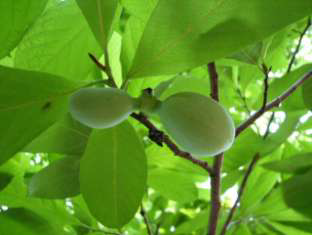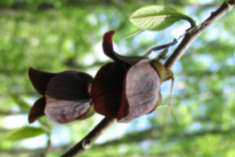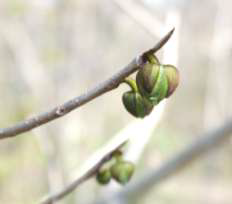 Pawpaw
Pawpaw
(Asimina triloba)
|
Classification |
| Kingdom: |
Plantae |
| Division: |
Magnoliophyta |
| Class: |
Magnoliales |
| Order: |
Magnoliopsida |
| Family: |
Annonaceae |
| Genus: |
Asimina |
| Species: |
A. triloba |
 Characteristics: The Pawpaw is a deciduous, often narrowly conical tree growing from about 12 feet to around 20 feet. The dark green, obovate-oblong, drooping leaves grow up to 12 inches long, giving the pawpaw a tropical appearance. The maroon flowers are up to 2 inches across and hang upside-down. They bloom from late March to early May. Each flower contains several ovaries, which explains why a single flower can produce multiple fruits.
Characteristics: The Pawpaw is a deciduous, often narrowly conical tree growing from about 12 feet to around 20 feet. The dark green, obovate-oblong, drooping leaves grow up to 12 inches long, giving the pawpaw a tropical appearance. The maroon flowers are up to 2 inches across and hang upside-down. They bloom from late March to early May. Each flower contains several ovaries, which explains why a single flower can produce multiple fruits.
Habitat: Pawpaw is an understory tree that likes wet, well drained, fertile soil. It can grow in upland environments if the soil is rich enough. The young plants need a lot of shade to do well.
 Range: Pawpaw can be found from Ontario and Michigan south to Florida and Texas.
Range: Pawpaw can be found from Ontario and Michigan south to Florida and Texas.
Native American Uses: The Pawpaw fruit was consumed raw or mashed, cooked or dried. In addition the inner bark was utilized to make string and ropes. Both the Cherokee and Rappahannock Indians ate the fruit from the Pawpaw tree.
Modern Uses: While the wild fruit was once harvested, the supply has greatly decreased as a result of the depletion of forests. Today, the fruit is mainly consumed by wildlife, but attempts have been made to cultivate the Pawpaw as a commercial fruit tree.